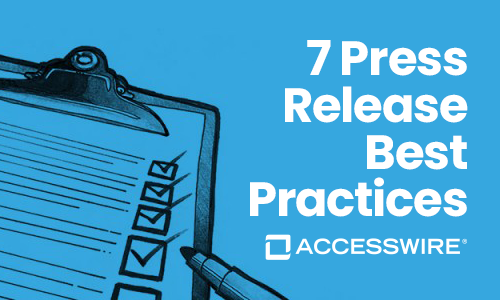Best Time to Send a Press Release
When it comes to press release best practices, timing is everything.
The lion’s share of today’s communications occurs in real-time, which means that establishing a rhythm for your business communications—with a media outlet, and with your public directly—requires tact and foresight.
This article will cover all things timing when it comes to scheduling your press release to ensure you remain in good standing with reporters.
The Best Days and Times to Send a Press Release
Despite the critical impact timing makes, PR and marketing professionals can’t always come to a concrete consensus on the best day or time to issue a press release.
Mondays, for instance, are still up for debate: are journalists primed to receive your messages after a refreshing weekend, or are their inboxes so inundated with other pitches that your message gets submerged in the deluge?
While some ambiguity remains around when to issue a press release pitch, there are some definitive times to avoid when scheduling your press release distribution service:
- Don’t send before 10 am or after 2 pm – If you issue your press release too early in the morning, you’ll likely be competing with a host of competitors pitching early morning announcements of their own. The later you send your pitch, the likelier it is to sink to the bottom of the inbox, and the to-do list. Unless your news is truly time-sensitive, it’s best to aim your pitches for the late morning and early afternoon.
- Don’t send it at the hour or half-hour mark – A trick of the trade: messages sent at off-kilter times, such as 10:41 am or 12:07 pm, are more likely to get noticed than messages sent at the hour or half-hour. Outlets frequently receive a fusillade of emails at exactly 10:00 and 10:30 am, so aim for your pitch to land at any minute mark other than 0 or 5.
- Don’t send on a Friday – While the jury is still out on Mondays, you can bet that Friday is the worst possible day of the week to issue a press release pitch. Unless your story is highly relevant to the outlet’s current press coverage or your journalist’s beat, Friday is likely billeted with stories in progress (and blitzed with deadlines).
- Don’t send after standard work-day hours – Many of us will admit to checking our inboxes from home, but it’s still in poor form to dispatch a press release after working hours. Remember, the press release pitch is a two-way street: you need to be in good standing with your recipient if you want your release to get covered, which means respecting their time in and out of the office.
Along these lines, this makes Tuesday, Wednesday, and Thursday (ideally between the off-kilter times of 10:01 am to 1:59 pm) the days when your press release pitch will have the best chance of striking a chord with recipients.
Timing Your Press Releases by Event Type
Today’s ease of direct-to-consumer marketing and communication has made it a cinch to air company news independently—through social media platforms, newsletters, and your brand’s website.
If you’re soliciting attention from journalists, and a wider public audience, it’s essential that your pitches are newsworthy and timed in service of your greater PR strategy.
Here are a few common occasions when different types of press releases may be sent out, and how to orchestrate them so they don’t get overlooked by your media contacts
Upcoming Events and Product Launches
If your organization is holding an event, submitting your pitch too early can make your announcement irrelevant, while sending it too late won’t give your public sufficient notice. Aim to send the events press releases at least three weeks prior.
New product or service releases tend to garner more interest and public enthusiasm when timed closer to the launch. Make your pitch one to two weeks before the release date, and be sure to include visuals, data, and a description of what makes this release relevant or beneficial in your pitch.
Business News
When it comes to keeping the public informed on internal news about your brand, there are a few common developments that may warrant a press release. These include:
- Funding announcements
- Mergers and acquisitions
- Awards or recognition
- New leadership
- Industry partnerships and alliances
In many cases, significant changes like these may need to stay confidential in a given time frame. In this case, you can deploy an embargo by indicating the date when your business news may be released to the public in your press release headline.
Crises, Emergencies, and Damage Control
Whether the emergency arises in the public domain, as in the COVID-19 pandemic, or as a private company matter, press releases are one of the most effective tools for maintaining brand integrity in the face of a crisis.
When to issue a press release about an urgent matter or breaking news will depend on the circumstances. Although it’s usually best to release a statement as briskly as possible, you should only issue a crisis communication press release after you:
- Define your target audience – Who is affected by the crisis, their relationship to your business, and what they need to hear to minimize the fall-out.
- Define your goals – While responding to an emergency can be a complex, lengthy process, you should still have a sense of what you are trying to achieve with your press release. Choose a SMART (specific, measurable, achievable, relevant, and time-bound) goal whose achievement you will track—ideally using analytic tools provided by your newswire distribution service.
- Get the facts straight – Emergencies can be complex, but you should be able to answer at least the five W’s: who is implicated, what occurred, where and when it happened, and your best explanation of why it occurred.
- Deliberate on your response – There’s no point issuing a crisis management statement if you don’t have a sense of how your brand will manage the crisis. Your press release should suggest how your brand hopes to move forward in the wake of the event, within the means at your disposal.
Whenever drafting your pitch for an urgent press release, be sure to indicate the time-sensitivity of your message by including “FOR IMMEDIATE RELEASE” in the subject line of your email.
5 Other Timing-Related Factors to Consider
In addition to the aforementioned rules of thumb, there are a few ways to ensure your press release comes off as apropos, rather than tone-deaf, in the broader scope of the news.
There are five other factors that can have a significant effect on whether or not your press release gains traction:
- Sensitivity to your reader’s time – Your pitch and press release should demonstrate a sensitivity to the strain on journalists’ and editors’ time. Keeping your language concise and punchy hones your message—and it shows respect for your media contact. Be sure to address your pitch personally so your message isn’t relegated to the spam folder.
- Time zones – Always remember to check (and double-check) your recipient’s time zone. This is a particularly crucial (and often overlooked) detail for companies operating cross-regionally or internationally, so avoid batching your press release distribution if your media contacts are located in different time zones.
- Major holidays – Use discretion when sending press releases during major holiday times. If your media list spans across the globe, it’s important to research time differences, local holidays, and national customs that may be affecting work in the area. Draft a media list spreadsheet to record where your contacts are operating, and periods to be avoided.
- Over-pitching – While it’s important to maintain a vocal presence in your industry, it is possible to overdo the frequency of your press releases. Every pitch you make should always be newsworthy for the specific media or news outlet to whom you’ve dedicated your pitch. If you over-blast your press releases, your messaging will not only seem off-key out of touch—you’ll risk being blacklisted by journalists entirely.
Lastly, the news climate has a make-or-break bearing on whether or not your press release is worthy of editorial attention. If your press release pertains to a hot-button issue, it may be an excellent time to drive visibility for your brand. Alternatively, getting involved in a fiery public debate can also be a defining moment for your brand identity formation—so choose your timing (and your words) wisely.
Send Your Press Release Right On-Cue with ACCESSWIRE
While there are some basic guidelines to follow for sending a press release, there is no one-size-fits-all approach when it comes to timing. There are also other elements to consider, such as how to end a press release or the difference between a media alert vs. a press release. Luckily, our team has you covered.
To align your PR distribution schedule with a progressive strategy, you’ll need the expertise of a press release service that can help you cut through the noise and garner the right kind of attention. ACCESSWIRE helps businesses get noticed with cutting-edge press release distribution, customized newsrooms, and premier data analytics to hone your public relations strategy and scale your target audience.
For more information on how (and when) we can help you send press releases that gain traction, reach out today.
Sources:
LinkedIn. When (and why) should you send out a press release.
LegalZoom. Why Press Releases are More Important Than Ever.
Fit Small Business. How to Write a Crisis Communication Press Release in 5 Steps.
Similar Blog Posts
PRODUCTS
ACCESSWIRE | All Rights Reserved




